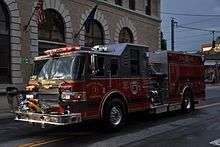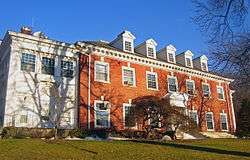Sleepy Hollow, New York
Sleepy Hollow is a village in the town of Mount Pleasant, in Westchester County, New York. The village is located on the east bank of the Hudson River, about 30 miles (48 km) north of New York City, and is served by the Philipse Manor stop on the Metro-North Hudson Line. To the south of Sleepy Hollow is the village of Tarrytown, and to the north and east are unincorporated parts of Mount Pleasant. The population of the village at the 2010 census was 9,870.[3]
Sleepy Hollow, New York | |
|---|---|
Village | |
The Old Dutch Church in 1907 | |
 Location of Sleepy Hollow, New York | |
| Coordinates: 41°5′31″N 73°51′52″W | |
| Country | United States |
| State | New York |
| County | Westchester |
| Town | Mount Pleasant |
| Area | |
| • Total | 5.21 sq mi (13.48 km2) |
| • Land | 2.24 sq mi (5.81 km2) |
| • Water | 2.96 sq mi (7.67 km2) |
| Elevation | 89 ft (27 m) |
| Population (2010) | |
| • Total | 9,870 |
| • Estimate (2019)[2] | 10,046 |
| • Density | 4,478.82/sq mi (1,729.18/km2) |
| Time zone | UTC-5 (Eastern (EST)) |
| • Summer (DST) | UTC-4 (EDT) |
| ZIP code | 10591 |
| Area code(s) | 914 |
| FIPS code | 36-67638 |
| GNIS feature ID | 0958934 |
| Website | www |
Originally incorporated as North Tarrytown in the late 19th century, in 1996 the village officially adopted the traditional name for the area.[4] The village is known internationally through "The Legend of Sleepy Hollow", an 1820 short story about the local area and its infamous specter, the Headless Horseman, written by Washington Irving, who lived in Tarrytown and is buried in Sleepy Hollow Cemetery. Owing to this story, as well as the village's roots in early American history and folklore, Sleepy Hollow is considered by some to be one of the "most haunted places in the world".[5][6][7]
The village is home to the Philipsburg Manor House and the Old Dutch Church of Sleepy Hollow, as well as the Sleepy Hollow Cemetery, where in addition to Washington Irving, numerous other notable people are buried.
History
The land that would become Sleepy Hollow was first bought from Adriaen van der Donck, a patroon in New Netherland before the English takeover in 1664. Starting in 1672 Frederick Philipse began acquiring large parcels of land mainly in today's southern Westchester County. Comprising some 52,000 acres (81 sq mi) of land, it was bounded by the Spuyten Duyvil Creek, the Croton River, the Hudson River, and the Bronx River. Philipse was granted a royal charter in 1693, creating the Manor of Philipsburg and establishing him as first lord.[8]
In today's Sleepy Hollow he established an upper mill and shipping depot, today part of the Philipse Manor House historic site. A pious man, he was architect and financier of the town's Old Dutch Church, said also to have built the pulpit with his own hands.[9]
When Philipse died in 1702, the manor was divided between his son, Adolphus Philipse, and his grandson, Frederick Philipse II. Adolph received the Upper Mills property, which extended from Dobbs Ferry to the Croton River. Frederick II was given the Lower Mills at the confluence of the Saw Mill and Hudson Rivers, the two parcels being reunited on his uncle's death. His son, Frederick III, became the third lord of the manor in 1751.[10]
In 1779, Frederick Philipse III, a Loyalist, was attained for treason. The manor was confiscated and sold at public auction, split between 287 buyers. The largest tract of land (about 750 acres (300 ha)) was at the Upper Mills; it passed to numerous owners until 1951, when it was acquired by Sleepy Hollow Restorations. Thanks to the philanthropy of John D. Rockefeller Jr., about 20 acres (8.1 ha) were restored as today's historic site.[10]
Geography
Sleepy Hollow is located at 41°5′31″N 73°51′52″W (41.091998, −73.864361).[11] According to the United States Census Bureau, the village has a total area of 5.1 square miles (13 km2), of which 2.3 square miles (6.0 km2) is land and 2.8 square miles (7.3 km2), or 55.58%, is water.[12]
Demographics
| Historical population | |||
|---|---|---|---|
| Census | Pop. | %± | |
| 1880 | 2,684 | — | |
| 1890 | 3,179 | 18.4% | |
| 1900 | 4,241 | 33.4% | |
| 1910 | 5,421 | 27.8% | |
| 1920 | 5,927 | 9.3% | |
| 1930 | 7,417 | 25.1% | |
| 1940 | 8,804 | 18.7% | |
| 1950 | 8,740 | −0.7% | |
| 1960 | 8,818 | 0.9% | |
| 1970 | 8,334 | −5.5% | |
| 1980 | 7,994 | −4.1% | |
| 1990 | 8,152 | 2.0% | |
| 2000 | 9,212 | 13.0% | |
| 2010 | 9,870 | 7.1% | |
| Est. 2019 | 10,046 | [2] | 1.8% |
| U.S. Decennial Census[13] | |||
As of the census[14] of 2010, there were 9,870 people, 3,181 households, and 2,239 families residing in the village. The population density was 4,054.7 people per square mile (1,566.9/km2). There were 3,253 housing units at an average density of 1,431.8 per square mile (553.3/km2). The racial makeup of the village was 61.01% Caucasian, 6.21% African American, 0.83% Native American, 3.25% Asian, 0.01% Pacific Islander, 23.47% from other races, and 5.22% from two or more races. Hispanic or Latino of any race were 51.04% of the population, many of whom are Ecuadorian, Dominican, Chilean, and Puerto Rican. Sleepy Hollow has one of the highest proportions of Ecuadorian American residents of any community nationwide, standing at 17.54% as of the 2010 census.
There were 3,181 households, out of which 36.0% had children under the age of 18 living with them, 51.5% were married couples living together, 13.4% had a female householder with no husband present, and 29.6% were non-families. 23.0% of all households were made up of individuals, and 8.7% had someone living alone who was 65 years of age or older. The average household size was 2.89 and the average family size was 3.37.
In the village, the population was spread out, with 25.0% under the age of 18, 8.9% from 18 to 24, 36.7% from 25 to 44, 18.9% from 45 to 64, and 10.5% who were 65 years of age or older. The median age was 34 years. For every 100 females, there were 103.0 males. For every 100 females age 18 and over, there were 101.9 males.
The median income for a household in the village was $54,201, and the median income for a family was $63,889. Males had a median income of $39,923 versus $32,146 for females. The per capita income for the village was $28,325. About 5.7% of families and 7.4% of the population were below the poverty line, including 9.3% of those under age 18 and 7.9% of those age 65 or over.
Notable landmarks
The Edward Harden Mansion, now serving as the administration building for the Public Schools of the Tarrytowns, Patriot's Park, Philipse Manor Railroad Station, Sleepy Hollow Cemetery, and the Tarrytown Light are listed on the National Register of Historic Places. The Old Dutch Church of Sleepy Hollow and Philipsburg Manor House are listed as National Historic Landmarks.[15] Also of note are Kingsland Point Park, Philipse Manor Beach Club, and the Rockefeller State Park Preserve.
Emergency services

As of 2014, the village's police department had 27 officers, four school crossing guards, and three civilian employees.[16] The village is also served by the New York State Police and Westchester County Department of Public Safety.[17] Police officers from the villages of Sleepy Hollow and Dobbs Ferry, the town of Greenburgh, and the New York State Police make up a Marine / H.E.A.T. Unit.[18] As of 2006, police base salaries in Sleepy Hollow were low compared to other Westchester County forces, in part due to the lower tax base.[19]
The Sleepy Hollow Fire Patrol, now the Sleepy Hollow Fire Department, was organized in 1876 and within 25 years had grown to five companies in three fire stations. As of 2012, there were three engines, two boats, and one tower ladder, as well as other equipment. The fire department is run by volunteers and responds to over 300 calls each year. The local hospital, Phelps Memorial, responds to hundreds of emergencies per year.[20]
Emergency medical services in Sleepy Hollow depend on volunteers assisted by paid staff. The Ambulance Corps has two basic life support ambulances. Mount Pleasant Paramedics provides advanced life support.[21]
In popular culture
Sleepy Hollow has been used as a setting or filming location for numerous media works, including films, games, literature, motion pictures, and television productions, including:
- Literature
- Sleepy Hollow is the setting of Washington Irving's short story "The Legend of Sleepy Hollow" (1820), its many adaptations in other media, and its major characters, Ichabod Crane and The Headless Horseman.
- Films
- The Curse of the Cat People (1944)
- The Scarlet Coat (1955), partially about American Revolutionary War general Benedict Arnold's associate John Andre's real-life capture in the village
- the film adaptation of the Dark Shadows television series, House of Dark Shadows (1970)
- Woody Allen's film Mighty Aphrodite (1995)
- Sidney Lumet's film remake Gloria (1999)
- the film remake The Thomas Crown Affair (1999)
- Tim Burton's Sleepy Hollow (1999), made primarily in England
- the film The Family Man (2000)
- the film Super Troopers (2001)
- the film Lord of War (2005)
- Robert De Niro's film The Good Shepherd (2006)
- the film Why Stop Now (2012)
- the film The English Teacher (2013)
- the Stephen King film adaptation A Good Marriage (2014)[22]
- the film adaptation The Girl on the Train (2016)
- the film The Meyerowitz Stories (2017), filmed primarily in and around Northwell Health's Phelps Memorial Hospital Center
- the film Wonderstruck (2017)
- Games
- One of the locations in Magicland Dizzy, is named after the village (1990)
- Sleepy Hollow is a location in the game Assassin's Creed Rogue (2014)
- Television
- The four-season television series Sleepy Hollow, though set in and around the village through the centuries, greatly expanded its population to 144,000, as indicated by a sign at the beginning of the pilot episode. Most of the series was filmed in North Carolina and Georgia, though several aerial shots of the actual village and surrounding region are incorporated into the series.
- Television personality and activist Caitlyn Jenner, a Sleepy Hollow High School alumnus, led TV journalist Diane Sawyer on a tour of the village and neighboring Tarrytown during her landmark coming-out interview on 20/20 in 2015.
Television shot on location in Sleepy Hollow includes:
- the "Tale of the Midnight Ride" episode of the television series Are You Afraid of the Dark?
- an episode of the television series Property Brothers during its Westchester-dedicated season
- the television series Divorce starring Sarah Jessica Parker
- the "Two Boats and a Helicopter" episode of the television series The Leftovers
- the television series Sneaky Pete
- the television series The Path
- an episode of the television series Man v. Food[23]
- the Showtime miniseries Escape at Dannemora
- the television series Pose
- the Netflix revival of the series Tales of the City
- an episode of the television series The Blacklist
Notable people
- Guy Adami, professional investor, trader and television personality
- Bob Akin (March 6, 1936 – April 29, 2002), business executive, journalist, television commentator and champion sports car racing driver
- Dave Anthony, stand-up comedian, writer, actor and podcaster
- Fay Baker (January 31, 1917 – December 8, 1987), actress and author
- Kathleen Beller, American actress
- Clarence Clough Buel (July 29, 1850 – May 22, 1933), American editor and author
- Keith Hamilton Cobb, actor best known for The Young and the Restless
- Abraham de Revier Sr. (c. 1650 – c. 1720), early American historian and elder of the Old Dutch Church of Sleepy Hollow
- Vincent Desiderio, realist painter
- Karen Finley, performance artist
- John C. Frémont (January 21, 1813 – July 13, 1890), American military officer, explorer, and politician who became the first candidate of the anti-slavery Republican Party for the office of President of the United States
- Margaret Hardenbroeck (c. 1637 – c. 1690), merchant in colonial New York and wife of Frederick Philipse, Lord of Philipse Manor
- Elsie Janis (March 16, 1889 – February 26, 1956), singer, songwriter, actress, and screenwriter
- Tom Keene (December 30, 1896 – August 4, 1963), actor best known for King Vidor's film classic Our Daily Bread and Ed Wood's film Plan 9 from Outer Space
- Ambrose Kingsland (May 24, 1804 – October 13, 1878), wealthy merchant and mayor of New York City
- Karl Knortz (August 28, 1841 – July 27, 1918), German-American author and champion of American literature
- Joseph L. Levesque, former President of Niagara University
- Joan Lorring (April 17, 1926 – May 30, 2014), Academy Award-nominated actress and singer
- Ted Mack (February 12, 1904 – July 12, 1976), radio and television host best known for The Original Amateur Hour
- Ralph G. Martin (March 4, 1920 – January 9, 2013), author and journalist
- Donald Moffat (December 26, 1930 - December 20, 2018), British actor
- Frank Murphy (April 6, 1876 - November 4, 1912), Major League Baseball player
- Frederick Philipse (c. 1626 – December 23, 1702), Lord of the Manor of Philipseborough (Philipsburg)
- Adam Savage, co-host of the television show MythBusters
- Gregg L. Semenza, 2019 Nobel Prize recipient
- Dirck Storm (1630–1716), early colonial American known for the Het Notite Boeck record of Dutch village life in New York
- Worcester Reed Warner (May 16, 1846 – June 25, 1929), mechanical engineer, entrepreneur, manager, astronomer, and philanthropist
- General James Watson Webb (February 8, 1802 – June 7, 1884), United States diplomat, newspaper publisher, and New York politician
- Eric Paschall, NBA basketball player
See also
- Administrative divisions of New York
- Historic Hudson Valley
References
- "2019 U.S. Gazetteer Files". United States Census Bureau. Retrieved July 27, 2020.
- "Population and Housing Unit Estimates". United States Census Bureau. May 24, 2020. Retrieved May 27, 2020.
- "Profile of General Population and Housing Characteristics: 2010 Demographic Profile Data (DP-1): Sleepy Hollow village, New York". United States Census Bureau. Retrieved November 18, 2011.
- Berger, Joseph (December 11, 1996). "North Tarrytown Votes to Pursue Its Future as Sleepy Hollow". The New York Times. Retrieved November 18, 2011.
- Hoeller, Sophie-Claire (October 28, 2014). "The 6 Most Haunted Towns in the World". Thrillist. Retrieved July 31, 2015.
- Summers, Ken (October 13, 2014). "Phantom Ships, Headless Skeletons, and Weeping Spirits: Investigating the Real Ghosts of New York's Sleepy Hollow". Week In Weird. Retrieved July 31, 2015.
- "The Sleepy Hollow Hauntings". Haunted Places to Go. Retrieved July 31, 2015.
- Eisenstadt, Peter (2005). "New York State: An Introduction". Encyclopedia of the State of New York (First ed.). Syracuse, New York: Syracuse University Press. p. 1199. ISBN 0-8156-0808-X.
- Edited Appletons Encyclopedia, Famous Americans: Biography of Frederick Philipse: "...He worked at the carpenter's trade for several years, aided in building the Old Dutch church, and is said to have made the pulpit with his own hands.
- Maika, Dennis J. (2005). "Philipsburg Manor". In Peter Eisenstadt (ed.). Encyclopedia of the State of New York (First ed.). Syracuse, New York: Syracuse University Press. p. 1199. ISBN 0-8156-0808-X.
- "US Gazetteer files: 2010, 2000, and 1990". United States Census Bureau. February 12, 2011. Retrieved April 23, 2011.
- "Sleepy Hollow, NY Population - Census 2010 and 2000 Interactive Map, Demographics, Statistics, Quick Facts". CensusViewer. Retrieved May 12, 2017.
- "Census of Population and Housing". Census.gov. Retrieved June 4, 2015.
- "U.S. Census website". United States Census Bureau. Retrieved January 31, 2008.
- "National Register Information System". National Register of Historic Places. National Park Service. March 13, 2009.
- "Police Department". Village of Sleepy Hollow. Retrieved July 28, 2014.
- "Sleepy Hollow Village Court". Law Office of Jared Altman. Retrieved July 28, 2014.
- "Special Operations Unit". Greenburgh Police Department. Retrieved July 28, 2014.
- Robert Bonvento (July 28, 2006). "What's Fair and What's Enough..., Negotiating A New Police Contract". River Journal. Retrieved July 28, 2014.
- Janie Rosman (July 7, 2012). "Sleepy Hollow Firefighters Well Equipped to Protect Village". The Hudson Independent. Archived from the original on July 28, 2014. Retrieved July 28, 2014.
- "Ambulance Corp". Village of Sleepy Hollow. Retrieved July 28, 2014.
- "Stephen King's 'A Good Marriage' Filming in Sleepy Hollow, NY This Month". OnLocationVacations.com. May 20, 2013.
- "Hit series 'Man v. Food' takes on Westchester". Lohud.com. Retrieved October 14, 2017.
External links
| Wikimedia Commons has media related to Sleepy Hollow, New York. |
- Village of Sleepy Hollow official website
- The Hudson Independent (local paper)
- Tarrytown-Sleepy Hollow Patch



